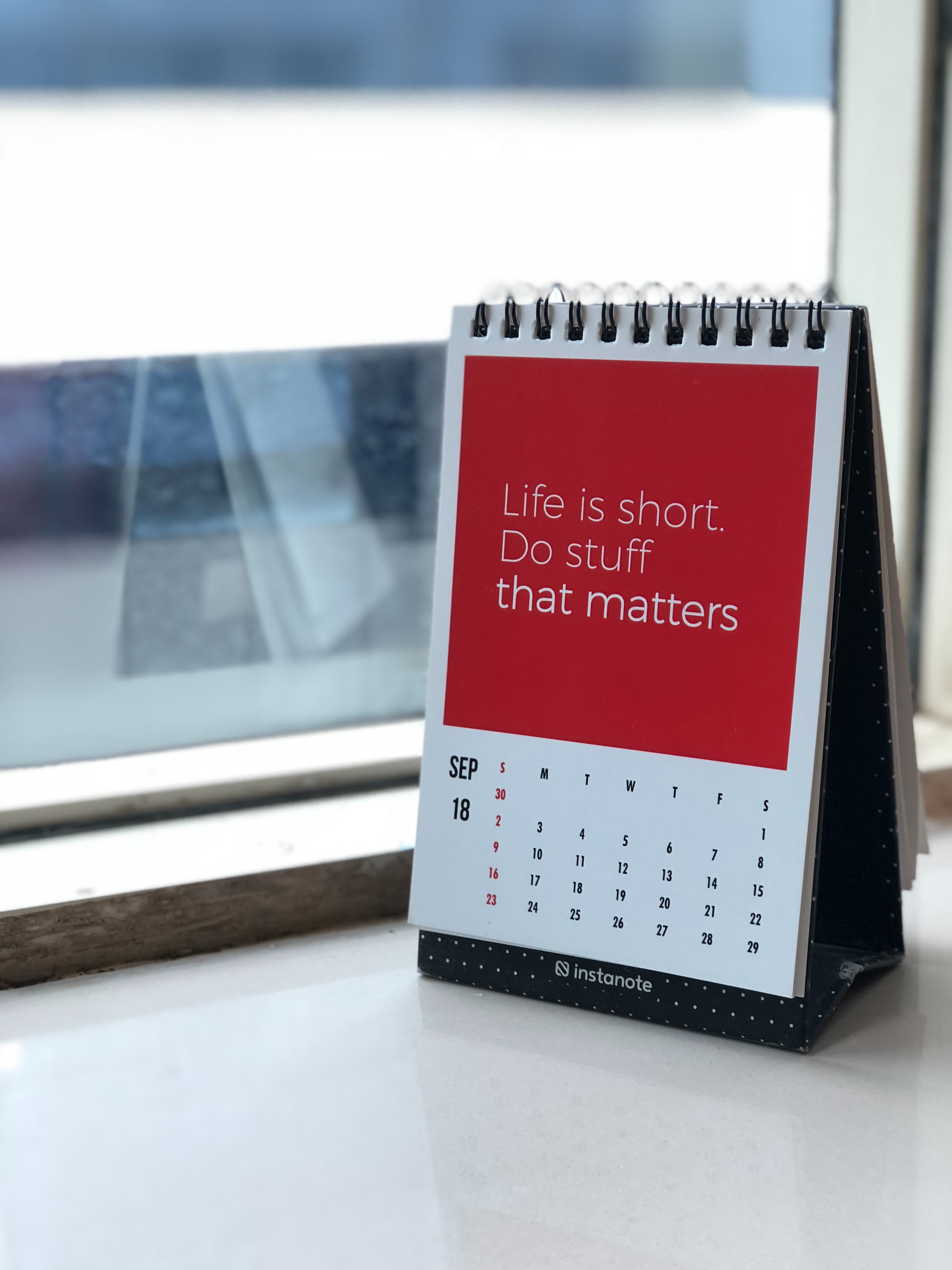Find out what your true motive is.

§ = = = = = = = = = = = = = = = = = Part 1 = = = = = = = = = = = = = = = = = = §
Look at today To-Do list, and monthly To-Do list, and then yearly To-Do list, we always want more but pay very little attention to our capacity to complete the task we set out to.
To figure out why we’re often unmotivated in the first place, we need to look deeper into ourselves.
The biggest of all is our motive isn’t desperate and/or the task is too large for completion.
We all have been there. Very often, we feel overwhelmed by how big the project is or, our initial motive assigned to its task doesn’t make us tail the completion. So what we did instead?
We turn to something that requires far less our mental efforts, such as scrolling our phone mindlessly. While relaxation is needed for our brain and body to recharge, too much of its short-term gains lose our vision that set in the long term. This game of life isn’t just the next few hours, but a lifetime of one combination of all little moments. Therefore, we cannot ignore all of these little moments and letting them go by, as they are far impactful then we originally thought of.

As my blog is an advocate of being healthy and fit, I will use health as my example throughout this article. It’s such an essential element one shouldn’t overlook. Nonetheless, you can apply the concepts and the method below to every task or project you do.
First off, what is your motive in completing the task?
Motivation often comes down to what our motive is and how much we want that to happen. Laying down a solid fundamental block of our motive is the best way to build our significance. Notice that our purpose in life and our motive for one specific thing, are different, though they are overlapped and should be interconnected in some forms.
Usually, our motive needs to be bigger than ourselves, but not excluding ourselves. For example, I want to be able to do 20 pull-ups. This is a very personal development of course. But if we change our motive to “ I’m achieving 20 pull-ups because I can show to the people who I love that they can achieve something significant too.” Or ” If I improve my overall well-being, then I will have better energy for myself to focus on the work, that brings a bigger impact of the contribution to the society.”
The reasons for your motive are endless, so find one that suits you best. And through achieving its course, your daily transformation is noticeable. Once we make our motive more desperate and bigger than ourselves, we can easily tune ourselves into working on its task.
Now, health isn’t something we complete, and then we forget. Same as many things, health is continuous and transformative. But it’s the tangible relationship we have with our body that reminds us don’t forget our center self in this fast pacing world we live in. It’s such a blessing that we can always come back to our mind and body.

After figuring out what the motive is, we move on to what to do when a task is too large for completion.
Method for completing a task:
Since health is a continuous movement of transforming the current us to a better version of ourselves, we can then find the specific task to improve and complete under this health element. (Now, I’ll use a tennis player as an example to show how it’s done.)
Step 1) Make A Decision
-
Just decide (Preferably within one sentence or less.)
-
-
“ I will create my healthy training routine this year and follow-through, for my best performance in tennis, so I can win the championship.”
-
**People do not decide to become extraordinary. They decide to accomplish extraordinary things. **
Step 2) Be Specific
-
-
I’m focusing on improving my agility and counter-movements this year. Specifically, I’ll be in my fittest and run across the side < 1 second.
-
^ I will train my mind and heart to be calmed. I will train my speed in responding to the incoming ball. I will specifically train my mobility, my back muscles in handling my racket and countering the incoming ball. I develop strategies and I will stretch more in the tight areas of my body so I can move faster, and smoother.
Step 3) Planning and Learning
-
-
I plan out specific movements that I can train myself to become better, such as “Leg day”, ” energy control”, “reflective approach”, “power boost”, “partner day of work out” and so on.
-
I learn biology, anatomy, and sport science. With all of this knowledge, I can apply them to my body and skills. Letting my body be in the best condition possible.
-
Step 4) Take Action
-
-
Go to the training spot. Start training, no excuses.
-
In love with the process
-
Be conscious of every set I’ve done, take note if necessary.
-
Constantly feeling the body in action, and thrive to be my better self.
-
Listen to the body talking. When it needs to stop, stops.
-
Stay hydrated
-
Reflect the session, and then repeat (with variation perhaps)
-
Step 5) Stretch, Rest, Connect, and Remind
-
-
Stretching is the essential practice for every sport. Daily stretching is a must at this point. it’s also a great way to reconnect with my body in a softer sense.
-
Goodnights of sleep and allowing my body to achieve a complete resting stage whenever possible. In regard to mental health for example: walking, and letting the train of thoughts going pass by…. All of these can help my brain get into relaxed mode, which in turn, I’m more recharged.
(No specific rules however. Any form of resting that allows my mind and body recover, that if I want to get back to “business” I can get my body to do so, is great.) -
Connect. From communities – connecting with others who have the same or similar interests – to the ones who are doing tennis in videos. Any form of connection is fine, as long as it’s the element that helps me to stay on track.
-
Remind myself how to improve better, by taking notes of my training thoughts, is a great way to improve my skill and help me develop deeper in its subject academically.
-
Step 6) Give, Give and Give
-
-
Learn one, teach one
-
It’s the best feeling that what I learn can give back to others. Some might be just struggling like myself before.
-
Help the communities whenever I can. Even it’s not tennis-related.
-
-

Understand your true motive, and follow the steps from 1 to 6, you will complete the task you’ve set out to.
§ = = = = = = = = = = = = = = = = = Part 2 = = = = = = = = = = = = = = = = = = §
During the process of completing, we need two extra inputs to make the progress bar forward.
1) Be aware of Consistency and Discipline
These two important factors are the driving forces to complete any task. So, be consistent and outrageously disciplined.
As Eric Thomas puts it,
” The grind is not when the sun comes out and everybody sees you. The grind is when you’re in the dark and nobody sees you. “
2) Find ways to stay motivated
Whether it’s the talk you have with yourself, or friends, or listening to the podcast, or youtube motivational videos, anything that helps you stay grounded. Nevertheless, self-generated motivation is superlative.
The reason why motivational speech is so powerful is that they usually offer new insight into the problem you’re facing or encouragement for you not to give up. But they all come down to one aspect, stay hungry.
§ = = = = = = = = = = = = = = = = = Part 3 = = = = = = = = = = = = = = = = = = §
Now, let’s tackle some of the common unmotivated factors people usually experience:
1. pessimistic view on the task completion
-
-
It’s easy to get consumed by the enormous amount of works we will be putting in. we need a better mindset and aim for dicing down the task into smaller manageable amounts of pieces so we can complete them.
-
2. Setting unrealistic goals
-
-
Look into our calendar, and visualise the timeline of completion. Just how long will it take for us? it’s completely okay to have a longer time. That’s being realistic. The second part is to develop methods to tackle the in-between, so we can finish the task timely.
-
3. Forgetting the benefits and rewards
-
-
When we turn our back from the project or goal, it’s because of the short-term gain our brain loves to have. We need another perspective, like what about 3 years from now, when the project is succeeded? What about 5,8, 10 years from now? What are the impacts?
-
Looking at long-term gain helps us to see a bigger picture, and allowing ourselves to set the eyes on our map better.
4. Not realising the importance of mini habits
-
-
Habits shape who we are in the physical realm. It’s important to know that our initial thoughts are the determination, but our habits, especially the smaller ones, like the patterns of thinking, the patterns of walking, the patterns of brushing the teeth, to the patterns of what we put the foods to our body, are shaping the future us every single day. We need to identify what works, what doesn’t, and replace them with a healthier habit.
-
5. Doubting our talents and potentials
-
-
It’s a very common case among us because we simply don’t trust ourselves. To achieve a goal, one must fully believe in their potential and talent within them. If we have a desire for something, it means we already have the gene within us. All we need is to unlock their full potentials.
-
6. Not seizing opportunities or don’t know how to identify one
-
-
The opportunities can be referred to as connections of the outside, of course. But the opportunity that within our controllable frame, like how we use our times wisely, also matters. Slotting and rearranging the times we have in a day to prioritise what we want to achieve on that day helps us to complete the tasks we always wanted. Time passes regardless of what we do, so knowing how to get on the time train and be productive about it can make us feel less guilty and boost our confidence to achieve more.
-
7. Not connecting within ourselves
-
-
Whatever the project is, there’re always a few of us on the table. Our energy, brain, body, soul, and spirit. If we don’t align them all in one place, it’s difficult to complete a task.
-

And that’s it! Thank you for reading this article, I hope it helps you understand how motivation works and what approach you can take to stay driven. After all, we only have one goal, which is to complete the task in this case. So whatever works for you, take that and use it.
If you like this article, please gives it a like or share it with your friends. Sharing is caring. And subscribe if you haven’t. :) until then, work hard, stay safe, stay healthy.
Photos by Cristofer Jeshke, Manasivta, Johannes Plenio, Sven Hornburg, Ian Dooley from Unsplash